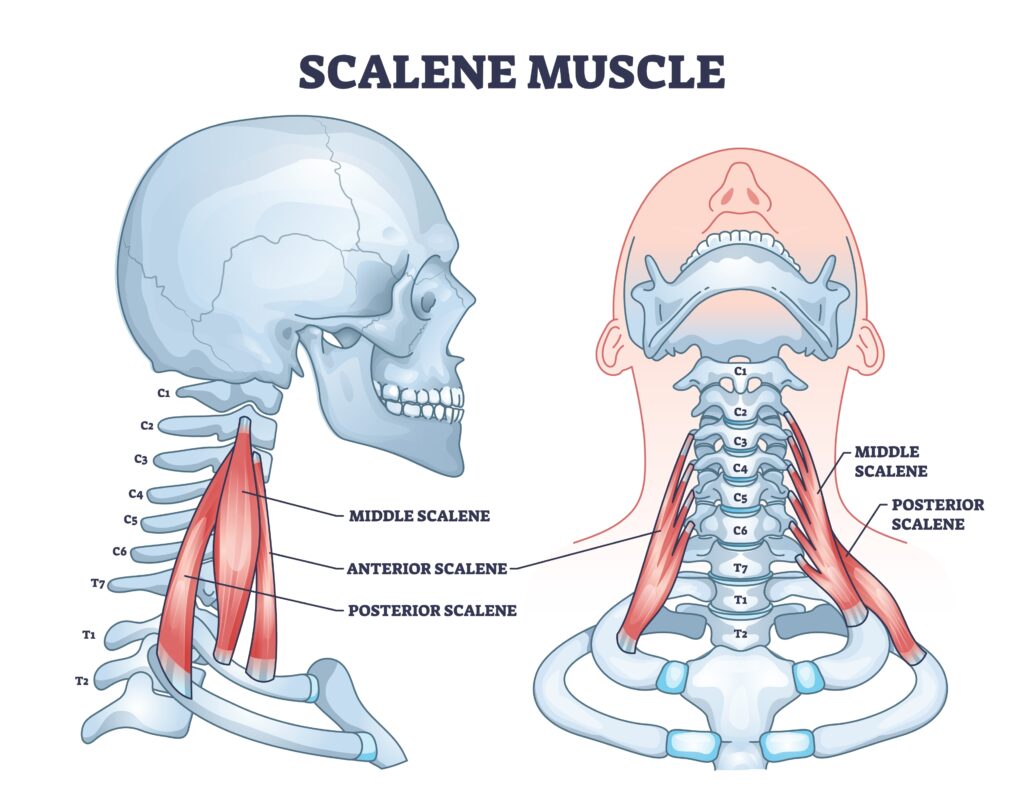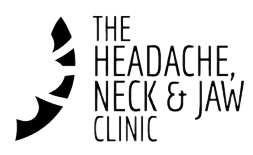Do your neck and shoulders feel sore and tense after working on a computer? You may be experiencing ‘Computer Mouse Shoulder’, more formally known as Scalene Muscle Tension. Scalene Muscle Tension is a very common neck and shoulder problem that our physiotherapists come across daily at the Headache, Neck and Jaw Clinic.
What is Scalene Muscle Pain?

‘Computer Mouse Shoulder’ is the common name for a dysfunction called Scalene Muscle Pain.
The Scalene Muscles are a group of 3 muscles on each side of the neck: the anterior scalene, middle scalene, and posterior scalene. The muscles originate at the upper and middle Cervical spine and attach to the first and second rib. The Scalene function involves neck movement, neck stabilisation, and assisting with breathing patterns.
A head-forward posture, as well as incorrect shoulder positioning while working at a desk, especially with a computer mouse, can lead to strain and dysfunction of the neck and shoulder muscles, especially the Scalenes.
Symptoms of Scalene Muscle Dysfunction
1. Neck Pain and Stiffness: Pain can be localised to the neck or radiate to the shoulder, upper back, or arm.
2. Numbness and Tingling: Compression of the nerves passing through the scalene muscles can cause numbness or tingling in the arm and hand.
3. Breathing Difficulties: In severe cases, Scalene Muscle Dysfunction can affect breathing due to its role in rib elevation.
4. Thoracic Outlet Syndrome (TOS): Prolonged Scalene Muscle Dysfunction can contribute to TOS, a condition where nerves and blood vessels in the space between the collarbone and first rib are compressed.
5. Tension headaches: Pull of the scalene muscles on one or one both sided of the shoulders could lead to a head forward posture resulting in loading and stiffening of the first 3 cervical vertebrae (upper neck) . A dysfunction of the upper neck ( C1-3) might be the cause of chronic episodic tension headaches or migraines.
Cause and Triggers of Scalene Muscle Pain
1. Poor posture: Working with arms extended in front of the body or maintaining a head-forward posture while using a mouse strains the neck and shoulder muscles, including the Scalenes.
2. Repetitive movements: Repeated, small movements of the mouse can lead to muscle fatigue and overuse injuries in the neck and shoulder region.
3. Muscle imbalance: When the muscles in the chest become tight, they can pull the shoulders forward, causing the neck and upper back muscles, like the scalenes, to work harder to compensate, leading to pain and stiffness.
Treatment and Tips to Prevent Scalene Muscle Tension
Physiotherapy

Treatment includes manual therapy of the cervical spine, the mid back, and the first and second ribs. Additionally, release work and stretching of the scalene muscle group are important to overall improve neck mobility, and combined with exercises to strengthen the neck, shoulder, and back muscles, can help improve posture and muscle endurance.
Ergonomic Workstation Assessment and Correction
Ensure your workstation is set up to promote good posture, with the mouse and keyboard within easy reach and the monitor at eye level. Ergonomic work equipment might be introduced to ease neck and shoulder strain.
Take breaks
Regular breaks to stretch and move around can help relieve muscle tension. A Physiotherapy home exercise program can help to strengthen and use the correct muscle groups without overloading the scalene muscles.
Good breathing pattern
Learning and applying a good and healthy breathing pattern, like abdominal breathing, can help offload the overworked scalene and neck muscles and help downregulate the nervous system.
By addressing workstation ergonomics, practicing good posture, and incorporating regular breaks and exercises, you can minimise the risk of Scalene Muscle Tension and other musculoskeletal problems associated with computer use.
The Headache Neck and Jaw Clinic team is highly trained to assess and treat the actual cause of the neck pain, empowering you to take steps in the direction of healing and a sustainable pain pain-free outcome.
Book an initial appointment online today, or phone the friendly Headache Neck and Jaw clinic team on 07 3266 3389 to discuss how we can help treat your neck pain issues.

Lisa Eisfeld is a trained physiotherapist from Germany. She has also studied advanced Manual therapy and finished her Osteopathy Diploma in 2018 at the School for Manual Medicine Berlin. Lisa has also attained her Watson Headache Institute Level 1 Foundation and Level 2 Consolidation courses. Read more about Lisa.

